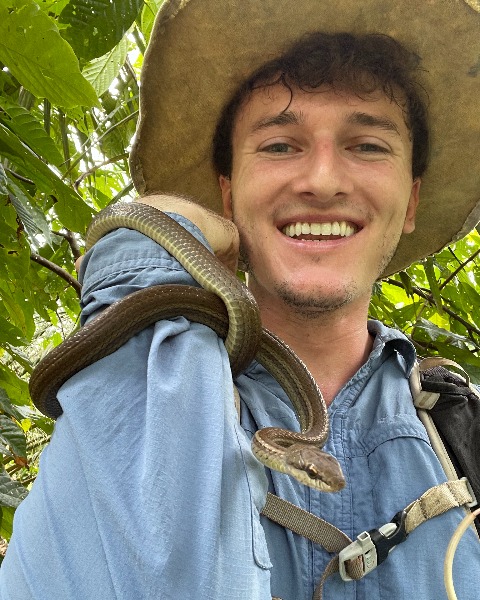Back
Contributed Talk
Session: Biodiversity 1
COS 4-1 - Diversifying oil palm plantations restores key microhabitats for forest dependent herpetofauna whereas monocultures favor disturbance specialists
Monday, August 15, 2022
1:30 PM – 1:45 PM EDT
Location: 513C

Edgar Francisco
Stanford University, United States
- RD
Rodolfo Dirzo
Stanford University, California, United States
Presenting Author(s)
Coauthor(s)
Background/Question/Methods
Humans consume more metric tons of oil palm (OP) than any other vegetable oil. Growing global demand is creating an OP boom in the Neotropics, where plantations cause habitat fragmentation, driving biodiversity loss. Considering the potential long-term volatility of OP plantations, farmers increasingly appreciate the value of assessing the potential benefits of combining OP production with other food and cash crops. Local farming families in Costa Rica, who have guided our project since its inception, view shifting away from plantation monocultures towards smallholder-run polycultures as a welcome change with socioecological benefits. Our study quantifies and details how smallholder OP polycultures and monocultures affect herpetofauna communities. We conducted over 400 hours of visual encounter surveys for amphibians and reptiles in eight matched-pairs of family-owned OP farms, half-hectare monocultures adjacent to half-hectare polycultures, palms intermingled with cacao, bananas, and Laurel trees. Our 192 farm surveys were split evenly between rainy and dry seasons and diurnal and nocturnal windows. We additionally surveyed local forests with the same effort (48 hectares searched), to compare herpetofauna diversity and habitat characteristics with the two farming practices. Our paired experimental design evaluates amphibian and reptile responses to OP diversification, juxtaposed with adjoining monocultures, for the first time.
Results/Conclusions
In OP, we recorded 1,975 amphibians across 25 species and 2,061 reptiles across 27 species, with polycultures hosting 59% of the total abundance. We found five more Serpentes species in monocultures (12), the same (15) Sauria in both treatments, and four more Anura in polycultures (23). 29 species were unique to forests, four to monocultures, and two to polycultures. Using rarefaction-extrapolation sampling curves for Hill numbers, we show that Shannon and Simpson diversity significantly, incrementally increase from monocultures to polycultures to forests. Our study details the first documented population of Anolis auratus in Costa Rica, a grassland specialist significantly associated with the monoculture experimental plots, which function like open savannas, harboring disturbance tolerant herpetofauna. Comparatively, we quantify how polycultures reintegrate structural heterogeneity and vital microhabitats like leaf litter, low perching sites, and closed canopies, which support more forest reliant species. Ultimately, both smallholder practices hold greater herpetofauna diversity than industrial plantations in the same region. It is crucial to consider specific macro and microhabitat alterations driven by land use changes to understand subsequent shifts in biodiversity. Diversifying oil palm monocultures, transforming them into polycultures, and reestablishing smallholder sovereignty are essential to alleviating biodiversity loss in the tropics.
Humans consume more metric tons of oil palm (OP) than any other vegetable oil. Growing global demand is creating an OP boom in the Neotropics, where plantations cause habitat fragmentation, driving biodiversity loss. Considering the potential long-term volatility of OP plantations, farmers increasingly appreciate the value of assessing the potential benefits of combining OP production with other food and cash crops. Local farming families in Costa Rica, who have guided our project since its inception, view shifting away from plantation monocultures towards smallholder-run polycultures as a welcome change with socioecological benefits. Our study quantifies and details how smallholder OP polycultures and monocultures affect herpetofauna communities. We conducted over 400 hours of visual encounter surveys for amphibians and reptiles in eight matched-pairs of family-owned OP farms, half-hectare monocultures adjacent to half-hectare polycultures, palms intermingled with cacao, bananas, and Laurel trees. Our 192 farm surveys were split evenly between rainy and dry seasons and diurnal and nocturnal windows. We additionally surveyed local forests with the same effort (48 hectares searched), to compare herpetofauna diversity and habitat characteristics with the two farming practices. Our paired experimental design evaluates amphibian and reptile responses to OP diversification, juxtaposed with adjoining monocultures, for the first time.
Results/Conclusions
In OP, we recorded 1,975 amphibians across 25 species and 2,061 reptiles across 27 species, with polycultures hosting 59% of the total abundance. We found five more Serpentes species in monocultures (12), the same (15) Sauria in both treatments, and four more Anura in polycultures (23). 29 species were unique to forests, four to monocultures, and two to polycultures. Using rarefaction-extrapolation sampling curves for Hill numbers, we show that Shannon and Simpson diversity significantly, incrementally increase from monocultures to polycultures to forests. Our study details the first documented population of Anolis auratus in Costa Rica, a grassland specialist significantly associated with the monoculture experimental plots, which function like open savannas, harboring disturbance tolerant herpetofauna. Comparatively, we quantify how polycultures reintegrate structural heterogeneity and vital microhabitats like leaf litter, low perching sites, and closed canopies, which support more forest reliant species. Ultimately, both smallholder practices hold greater herpetofauna diversity than industrial plantations in the same region. It is crucial to consider specific macro and microhabitat alterations driven by land use changes to understand subsequent shifts in biodiversity. Diversifying oil palm monocultures, transforming them into polycultures, and reestablishing smallholder sovereignty are essential to alleviating biodiversity loss in the tropics.
